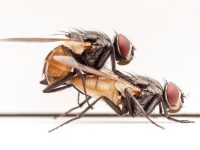
Legend has it that, in a distant time, when the sun was young and shone brighter than ever Africa was almost completely dry. One night, a youthful, thirsty, white-haired zebra visited one of the few waterholes that had survived the sweltering heat. This waterhole in particular was ruled by a greedy baboon who zealously guarded it in the warmth of a huge campfire. The young zebra challenged the baboon and the two clashed in a fierce battle that ended with a powerful kick that sent the baboon flying in the air to land, defeated on its back. The zebra, exhausted and dazed by the effort, accidentally stepped on the fire and was scorched. And thus, according to the San people of the Kalahari, the baboon’s buttocks were forever red and bare, and the zebra’s coat was striped.
The real story of how and why the zebra has stripes is an evolutionary mystery that has puzzled ethologists, and evolutionary biologists in general, for over a hundred years. At least since Alfred Rusell Wallace and Charles Darwin debated the function of the zebra’s stripes, which are unique among mammals. Since then, at least eighteen different hypotheses have been proposed.
The first thing we need to clarify is that zebra stripes are white. It is the absence of melanin during development that gives the zebra its stripes, so it is a black equid with white stripes, not the other way round. As for its function, available hypotheses can be grouped around five ideas. The first and oldest, as discussed by Wallace and Darwin, is that it is camouflage, but this idea has been firmly rejected. If anything, zebra stripes are more easily spotted by their usual predators. The second is that the intricate pattern facilitates social cohesion and allows individuals to be recognised, as a sort of fingerprint. This, however, is inconsistent with the fact that many other equids can recognise their conspecifics without this aid, or that mutant zebras without stripes are treated as normal zebras. The third is that the pattern confuses predators, making it difficult to judge the number, size or direction of zebras in a herd. While it is true that there are optical effects that work in a similar way, what we know about the visual system and behaviour of lions and hyenas does not support this idea. The fourth (and perhaps more sophisticated) idea is that the stripes are a thermoregulatory mechanism that would generate local convection currents driven by the temperature difference between the black and white stripes. This is an attractive idea, but several experiments cast doubts on it.
In fact, the only hypothesis that has any firm empirical support is that zebra stripes act as a defence against tabanids, glossinids (tsetse flies) and other parasitic species that are particularly dangerous both because of the wounds they cause and because they are vectors for potentially fatal diseases such as equine infectious anemia. Although we do not understand exactly why, when a tabanid approaches a zebra at close range, something in the stripes causes it to fail to coordinate its landing and makes it difficult for it to feed. This also happens, as several experiments have shown, to horses, cows or other similarly sized mammals «disguised» in a blanket that mimics a zebra’s coat. In addition, zebra stripes are more pronounced in zebra populations where these parasites are more common, suggesting that they have evolved in response to their presence.
Voracious, stubborn, greedy and unruly flies may not work like bees or glow like fireflies, but they may well be responsible for the unique stripes on zebras.





